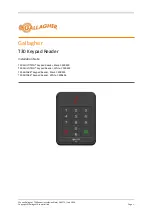
37
Every household should establish and regularly practice an escape plan in the event of a fire. The following
steps, recommended by the National Fire Protection Association, can be used as a guide in developing your own
emergency plan.
Establish a meeting place outdoors, away from the house, where
everyone can gather and account for those missing. Choose
someone to notify the authorities. Choose someone to ensure that
nobody returns to the house.
Many die going back inside
.
.
.
.
.
Plan on your detector or alarm system sounders waking all
occupants.
Determine two means of escape from each room, especially
the bedrooms, since most fires occur at night when everyone is
asleep. One escape path should lead to a door that permits normal
exit from the house. The other may be an easily opened window
(used if the primary escape path is blocked).
Sketch a floor plan, showing doors, windows, stairs, and rooftops
that can be used for escape. Indicate escape routes for each room
(see examples below). Post copies of the sketch in each room.
Remember to keep all escape routes free from obstruction.
Keep all bedroom doors shut while the occupants are asleep.
This will prevent deadly smoke from entering the rooms while you
escape.
.
Escape quickly. But don't panic.
Before you open a door, check to see if it's hot. If it is hot, don't
open it. Use an alternate escape route. Even if the door is cool,
use your shoulder to open it cautiously. Be ready to slam it closed if
heat or smoke rushes in.
When moving through a smoky area, stay as close to the floor as
possible. Crawl and hold your breath.
.
.
.
BEDROOM
FAMILY
ROOM
BEDROOM
BATH
BEDROOM
LIVING ROOM
LAUNDRY
BATH
KITCHEN
DINING
FIRST FLOOR
S A M P L E
SECOND FLOOR
S A M P L E
Содержание System 238
Страница 1: ...B Using your LED Plus keypad System 2316 System 238 System 2316i System 238i...
Страница 41: ...Y E S NO BYPASS ATION 41...
Страница 42: ...Y E S NO BYPASS ATION...





































